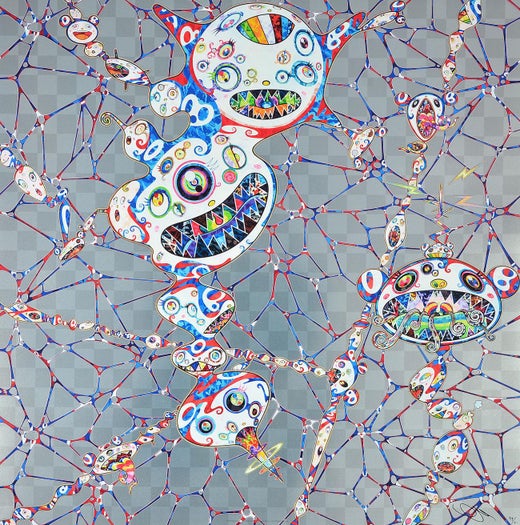Takashi MurakamiFlower Sparkles
About the Item
- Creator:Takashi Murakami (1963, Japanese)
- Dimensions:Height: 19.82 in (50.35 cm)Width: 18.82 in (47.81 cm)
- Medium:
- Period:
- Condition:
- Gallery Location:Miami, FL
- Reference Number:1stDibs: LU162229175692
Takashi Murakami
Japanese contemporary artist Takashi Murakami may be famous among collectors for the psychedelic flowers and chaotic cartoons that populate his prints and paintings, but artists likely know him as the theorist behind the contemporary art movement he calls “Superflat.”
Partially inspired by the Pop art of Andy Warhol, in which celebrity culture and mundane mass-produced items became the focus of bright and colorful works that both celebrated and criticized consumerism, Murakami’s Superflat encompasses painting, sculpture, digital design and more to present a subversive look at consumerism but is also an effort to blend fine art and lowbrow culture.
A multifaceted and remarkably influential artist as well as a compulsive art collector, Murakami has collaborated with brands such as Louis Vuitton, while one of his most famous Superflat works is the teddy bear on the cover of the Graduation album by American rapper Kanye West.
In 1993 Murakami earned his Ph.D. from Tokyo University of the Arts, where he was trained in nihonga, a style of painting that originated in the late 19th century by artists who worked to preserve and promote the conventions and processes associated with traditional Japanese art. While practicing nihonga, Murakami began to realize that his beliefs didn’t align with the tradition, so his art subsequently took on a satirical feel that embodied a critique of the movement. Before long, his style took a drastic turn, embracing otaku, a rising postwar cultural phenomenon among Japan’s younger crowd who loved anime and manga. (Otaku is also integral to Superflat.)
This is when Murakami’s most well-known character, Mr. DOB, was born. This anime-inspired icon, which Americans might interpret as a cross between Walt Disney’s Mickey Mouse and Lewis Carroll’s Cheshire Cat given its pronounced ears and broad and menacing grin, was part of the artist’s endeavor to elevate the otaku subculture but also to target mass consumerism. While Murakami conceived of Mr. DOB years ahead of his 2000-era Superflat theory, there is much common ground between the two. Not unlike his other creations, Murakami’s Mr. DOB is equal parts erotic, disturbing and cartoonish — an incisive mockery of the mingling of commerce and fine art so prevalent in Japanese popular culture.
Find original Takashi Murakami prints, sculptures and other art on 1stDibs.
You May Also Like
2010s Pop Art Figurative Prints
Varnish, Archival Paper, Giclée, Screen
2010s Modern Figurative Prints
Archival Paper, Screen
21st Century and Contemporary Contemporary Portrait Prints
Archival Paper, Archival Pigment
2010s Modern Figurative Prints
Archival Paper, Screen
2010s Pop Art Figurative Prints
Varnish, Archival Paper, Giclée, Screen
2010s Pop Art Figurative Prints
Varnish, Archival Paper, Giclée, Screen
1960s Modern Figurative Prints
Archival Paper
21st Century and Contemporary Contemporary Portrait Prints
Archival Paper, Etching
21st Century and Contemporary Contemporary Portrait Prints
Archival Paper, Etching
21st Century and Contemporary Contemporary Portrait Prints
Archival Paper, Etching
